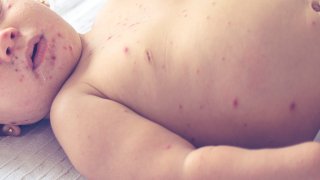
It starts with a high fever — in some cases, up to 105 degrees Fahrenheit. Children may also feel achy or lose energy.
Roughly a day after the fever sets in come the three C’s of measles: cough, conjunctivitis (pink eye) and coryza (a runny nose). Some kids may be sensitive to light and start to squint, as well.
But the most characteristic signs of measles — tiny white spots in the mouth and a blotchy rash that spreads from head to toe — don’t appear right away.
The spots typically show up on the insides of the cheeks near the molars about two to three days after symptoms start. The rash — which consists of flat, red spots — breaks out between days three and five, forming at the hairline before spreading to the neck, torso, arms, legs and feet.
Feeling out of the loop? We'll catch you up on the Chicago news you need to know. Sign up for the weekly Chicago Catch-Up newsletter here.
“It’s as if you sort of poured a bucket of measles on your head, and then it works its way down,” said Dr. Paul Offit, who had measles as a child before vaccines were available. Offit is the director of the Vaccine Education Center at Children’s Hospital of Philadelphia.
Already this year, 35 measles cases have been recorded across 15 states, according to the Centers for Disease Control and Prevention. That puts the U.S. on track to surpass last year's total of 58.
The two biggest outbreaks have been in Florida — which recorded its 10th measles case over the weekend — and Pennsylvania, which identified nine cases over a monthlong period from December to January.
Around 1 to 3 out of every 1,000 children infected with measles die from respiratory and neurological complications. In rare cases, measles can also lead to blindness or long-term vision problems.
But many people may not be aware of its symptoms or severity, according to doctors who treat measles patients. And even for those who recover fully and quickly, the illness can be painful, Offit said: “If you look at children who have measles, they’re miserable.”
'I was getting delirious at one point'
By the time the measles rash reaches the lower body, blotches on the head and the face begin to coalesce into a giant red patch, said Dr. Mark Kline, an infectious disease specialist at Children’s Hospital New Orleans.
“Usually the illness itself peaks during that phase,” Kline said. “Day four or five, the fever will be the highest, the child’s symptoms will be the most severe.”
Randy Blaser, 67, of Lake County, Illinois, said he had measles as a child in the 1960s.
“I had a pretty severe case of it,” Blaser said, though he wasn’t able to provide medical records from the time. He said he developed the characteristic rash and was sick for about a week.
“Most of what I remember is from what my mom told me about how I was getting delirious at one point. I had a really high fever, and she was freaking out,” Blaser said.
Shortly after the illness, he said, he had to get glasses for nearsightedness. Blaser suspects the two are linked, given the timing, though his doctors don't necessarily think so, he said.
“Of all the childhood diseases, that was the worst one,” he said.
There is no treatment for measles, so doctors focus on helping people manage their symptoms. If an unvaccinated person is exposed to measles and hasn't developed symptoms yet, a vaccine can ward off infection if it is administered within 72 hours. Another option is a preventive injection called immune globulin, which must be given within six days of exposure.
Measles symptoms typically last 10 days, assuming patients don’t have severe complications, like swelling of the brain, pneumonia or secondary bacterial infections.
For many, the rash slowly clears up over the sixth through ninth days, Kline said, but it may leave behind brown or peeling skin.
If a fever goes away and then comes back, Kline said, that could indicate a secondary infection. Symptoms like confusion, loss of consciousness, headaches, vomiting or seizures might be signs of a neurological issue, he added, which can sometimes result in deafness or intellectual disability.
An early spike in measles cases
Before the first measles vaccine became available in 1963, nearly all children got the disease by age 15. Around 3 million to 4 million people in the U.S. were infected every year, and 400 to 500 people died of measles annually.
Measles has been considered eradicated in the U.S. since 2000, but there have been occasional outbreaks since then, often originating in other countries.
The U.S. nearly lost its measles elimination status in 2019, when it recorded more than 1,200 cases — the most since 1992. The majority were related to ongoing transmission in large, close-knit Orthodox Jewish communities in New York.
In the two major outbreaks this year, measles spread at a children’s hospital and day care facility in Philadelphia and an elementary school in Florida. All nine patients in Broward County, Florida, are children, and two are 4 years old or younger. The state's 10th case is person in their 20s in Polk County.
Meanwhile, Arizona reported two measles cases last week, and Louisiana recorded two in the New Orleans area.
Kline, who was involved in the care of the Louisiana patients, said both are children under 2 and neither required hospitalization.
But now that measles is relatively rare, he said, “the vast majority of doctors and nurses who are out there staffing ERs and clinics and on hospital floors these days have never seen a case.”
Several years ago, Kline said, he assisted with a patient who had a high fever and a rash after doctors struggled to find a diagnosis.
“I walked into the room, opened the door, and from across the room I said, ‘That’s measles,’” Kline said. “The child had been in the hospital for two or three days already, exposing people.”
Vaccination rates have fallen
Most people who get measles are unvaccinated. Two shots are 97% effective, according to the CDC.
Children in the U.S. should get their first doses between 12 and 15 months and their second between 4 and 6 years old.
For nearly 10 years, 95% of U.S. kindergartners had received both doses. But the rate fell to 93% in the 2022–23 school year — which is likely to explain why the country has had so many cases in the last two months, doctors said.
“In order to prevent any pandemic or epidemic for measles, you really have to have an immunization rate of 95%,” said Dr. Samir Midani, the division chief of pediatric infectious diseases and immunology at Nemours Children’s Health in Jacksonville, Florida.
In the Broward County School District, where Florida's current outbreak is, 91.7% of students in the 2021-22 academic year had received all their required vaccines, including measles shots.
“Vaccinated people may get it, but really the effectiveness of the vaccine is very high,” Midani said. “I would worry about somebody who is not immunized.”
This story first appeared on NBCNews.com. More from NBC News:



